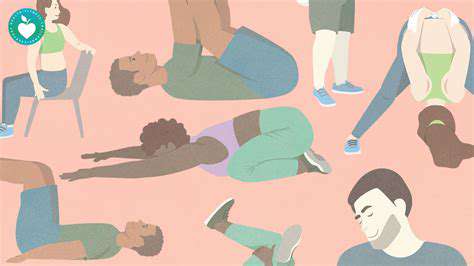Coping with a Sudden Panic Attack: Immediate Action Steps
Recognizing the Physical Symptoms
Panic attacks often manifest with a range of physical sensations, making them easily mistaken for other medical conditions. These physical symptoms can be quite frightening, and understanding them is crucial for managing your anxiety. Rapid heartbeat, shortness of breath, and chest pain are common, often leading individuals to fear a heart attack or other serious illness. Sweating, trembling, and dizziness are also frequently reported, further contributing to the feeling of impending doom.
Recognizing these physical responses as panic attack symptoms, rather than signs of a more serious issue, is a critical first step in coping with them effectively. Seeking medical attention if you're unsure about the cause of these symptoms is always recommended, but identifying the pattern of physical sensations associated with your panic attacks can significantly aid in self-management.
Identifying the Emotional Symptoms
Beyond the physical sensations, panic attacks are often accompanied by intense emotional responses. Feelings of overwhelming fear, terror, or impending doom are common, creating a sense of helplessness and loss of control. This emotional turmoil can be profoundly distressing, leaving individuals feeling trapped and unable to function normally.
Along with these core emotions, feelings of anxiety, dread, and even a sense of detachment from reality can accompany a panic attack. Learning to recognize and label these emotional responses can help you develop coping strategies to manage them effectively.
Understanding the Cognitive Symptoms
Cognitive symptoms, often less noticeable than physical or emotional ones, can also play a significant role in a panic attack. These include racing thoughts, intrusive thoughts, and difficulty concentrating. During a panic attack, the mind can become flooded with negative or catastrophic thoughts, making it hard to think clearly or rationally.
These racing thoughts often contribute to the feeling of being overwhelmed and unable to cope. Recognizing these cognitive patterns is key to managing the overall panic attack experience.
Recognizing the Behavioral Symptoms
Panic attacks can also manifest in behavioral changes. These can include avoidance behaviors, such as avoiding situations where you've experienced a panic attack in the past. This avoidance can significantly limit your ability to participate in everyday activities and lead to feelings of isolation and social withdrawal.
Other behavioral symptoms may include restlessness, agitation, and difficulty sleeping. These behavioral changes are often a direct result of the fear and anxiety associated with panic attacks, highlighting the importance of addressing the underlying causes.
The Importance of a Timely Diagnosis
Recognizing the symptoms of a panic attack is the first step towards effective management. Understanding the various manifestations, from physical sensations to cognitive distortions, is essential for developing appropriate coping mechanisms. If you experience these symptoms regularly, seeking professional help is crucial.
A qualified mental health professional can conduct a thorough assessment, differentiate panic attacks from other conditions, and develop an individualized treatment plan. Early diagnosis and intervention can significantly reduce the impact of panic attacks on your life and improve your overall well-being.
Developing a Personalized Coping Strategy
Developing a personalized coping strategy is vital for managing panic attacks effectively. This strategy should incorporate various techniques, tailored to address the specific triggers and symptoms you experience. Techniques such as relaxation exercises, breathing techniques, and cognitive restructuring can be incorporated into your daily routine to proactively manage anxiety and reduce the frequency and intensity of panic attacks.
Seeking support from a therapist or support group can provide valuable guidance and encouragement as you develop your coping mechanisms. Remember, you are not alone in this experience, and with the right tools and support, you can effectively manage your panic attacks and live a fulfilling life.
Grounding Techniques: Bringing Yourself Back to the Present

Grounding Techniques: A Practical Guide
Grounding techniques are essential tools for managing stress and anxiety, providing a sense of stability and control in challenging situations. They are simple yet powerful practices that help you reconnect with the present moment, reducing feelings of overwhelm and promoting a sense of calm. Learning and practicing these techniques can significantly improve your overall well-being and resilience.
Deep Breathing Exercises
Deep breathing exercises are a cornerstone of grounding techniques. Incorporating slow, deliberate breaths can quickly shift your focus from racing thoughts to the physical sensation of your breath. By focusing on your breath, you anchor yourself in the present moment, reducing the intensity of anxious thoughts and promoting relaxation.
Practicing slow, deep breaths can help regulate your heart rate and blood pressure, which can significantly impact your overall sense of calm and well-being.
Mindful Sensory Awareness
Mindful sensory awareness involves paying close attention to the details of your surroundings. Notice the textures of objects, the smells in the air, the sounds around you, and the sensations in your body. This practice helps you anchor yourself in the present moment, connecting you to your immediate environment. It allows you to move away from distracting thoughts and anxieties, focusing instead on the tangible aspects of your surroundings.
Progressive Muscle Relaxation
Progressive muscle relaxation involves systematically tensing and releasing different muscle groups in your body. This technique helps identify and release physical tension, which often accompanies stress and anxiety. By consciously relaxing your muscles, you can reduce physical tension, promoting a sense of calm and grounding. By focusing on the sensations of tension and release, you bring your attention to the present moment, reducing the impact of overwhelming thoughts and anxieties.
Body Scan Meditation
Body scan meditation is a practice where you systematically bring your attention to different parts of your body, noticing any sensations without judgment. This practice helps you connect with the physical sensations in your body, which can be particularly helpful during moments of stress or anxiety. It allows you to appreciate the present moment, connecting you to a sense of grounded stability.
Using Visual Imagery
Visualizing calming scenes or places can be a powerful grounding technique. Imagine a peaceful beach, a serene forest, or a comfortable room. Focusing on these images can help shift your attention away from stressful thoughts and feelings, promoting relaxation and a sense of calm. By engaging in this visualization, you can detach from the current situation and find solace in a more peaceful environment, creating a sense of grounding.
Connecting with Your Senses
Engage your senses to anchor yourself in the present moment. Pay attention to the taste of your food, the smell of flowers, or the feel of the sun on your skin. These sensory experiences can help you connect with the present moment, reducing the intensity of anxious thoughts and promoting a sense of groundedness. Using your senses in this way brings you back to the present moment and can help to reduce stress and anxiety. This practice cultivates a deep connection to your surroundings and promotes a sense of calm.

